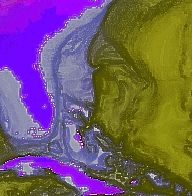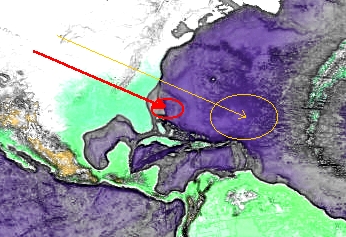Was This Atlantis?
Examination of the possible location and the reason of its disappearance.
Version Française.
The location of impact.
In
order to move the poles, the Earth should, as we have seen earlier,
have been touched at a particular place. The exact location can
obviously vary depending on the angle at which the celestial body had
struck the Earth. We cannot ascertain with certainty an other
important condition. It's in fact whether the earth revolved once
faster or slower than today. Namely, if it turns faster now than
before, the impact should have been in the same sense, if not, in the
against-direction of rotation.
Possible areas of impact:
|
Faster rotation,
impact
in the same sense.
|
Slower rotation,
impact
in against-direction.
|
|
The
Bermuda Triangle
|
Northwest
Pacific Ocean
|
|
20°
- 40° North et 60° - 100° West
|
40°
- 70° North et 140° - 180° East
|
|
The
Australian continent
|
South
of Cape of Good Hope
|
|
20°
- 40° South et 80° - 120° East
|
40°
- 70° South et 0° - 40° West
|

It's a curious coincidence that the coast to the city of
Charleston, the Bermuda Triangle thus, shows indeed a structure
resembling an oval crater seven hundred to five hundred kilometers.
This suggests us that this is an impact caused by a celestial object
of fifty kilometers, striking the Earth at an angle. In addition to
what we can see in the tables is that the size and location
corresponds roughly to what is expected!
A little reminder, the move of
poles is the same process as the change in orientation of the
satellites, a small boost in the right place is enough to change the
position. The only difference with satellites is that the Earth had
no pulse in the opposite direction to stop the additional rotation.
In fact, the result of the addition of the original and additional
rotation was that the earth began to rotate on a different axis with
a different speed. It would, in fact, suffice to add a North-South
component to make the Earth rotate on another angle. We have, on the
other hand, two possibilities left; one where a North-South component
was added against-direction of rotation, then a second, where a
North-South component was added in the same direction. Why
North-South in one of the two and South-North in the other? It must
be remembered, as we saw earlier, that we had a choice between a
slowdown of the current North Pole, or an acceleration of the former
North Pole, located somewhere on the continent of Greenland. As we
have seen, 12'000 years ago, it was the today's North Pole which was
describing a circle around a point which lies on the current
Greenland. But nowadays it's this point on the continent of
Greenland, which describes a circle around the pole of today. It
must thus, for having reversed the situation, that the current North
Pole has been slowed down, or that the former North Pole once located
on the mainland of Greenland, has been accelerated. To find the
speed of change, simply multiply the speed of rotation at the equator
(463 m / sec.) with the sine of the angle of displacement.
(Cosine of the degree of latitude!) But as
we have seen, adding that speed of movement requires a lot of energy,
which is calculated by multiplying the mass with the speed squared.
We should realize us that the amount of energy required is so
high, that it's necessary to use a unit of measurement sufficiently
large. We can at this stage take as reference the the most powerful
thermonuclear hydrogen bomb in history, the “Tsar Bomba”,
tested by the Soviet Union, which was 57 megatons TNT.
As mentioned above, we should multiply the mass by the square of
the speed to find out how much energy we need to move the poles.
Speed is the sine of the angle of displacement multiplied by the
speed of rotation at the equator. Then the mass is due to the
spherical shape of the Earth, about two thirds of the landmass. The
following table summarizes different angles with the speed and the
additional amount of energy needed in terms of number of “Tsar
Bomba's” of 57 megatons of TNT each.
Table of angles of displacement speed and force
required:
|
Angle.
|
Rotation
speed.
|
Number
of bombs “Tsar Bomba”
|
|
13°
|
104
m/sec.
|
7 435 000
|
|
14°
|
112
m/sec.
|
8 004 000
|
|
15°
|
120
m/sec.
|
8 570 000
|
|
16°
|
127
m/sec.
|
9 078 000
|
|
17°
|
135
m/sec.
|
9 650 000
|
The table above does not mean that it's enough to blow almost
ten million bombs such as a “Tsar Bomba” in the
right place to make a pole movement. It wants to say only how much
energy would be required to perform such an operation. What happened
is that a relatively small mass had struck the Earth with a
considerable speed. Upon impact, the result of mass multiplied by
velocity squared was transformed into energy. It's this energy that
was in turn partially converted into movement of the Earth. During
this conversion we should probably count as much as twenty percent
that had been lost as a warming of seawater. This small loss of
energy still corresponded to an explosion of 1'929'000 bombs of the
type as the “Tsar Bomba”.
We can, since we know the amount
of energy needed, seek the relationship between the size and velocity
of celestial objects. An example of common knowledge is, that as a
general rule, a meteorite impact leaves a crater ten times its size.
In other words, an object ten kilometers leaves a crater of hundred
kilometers. In drawing up an array of objects of different sizes and
their speed, we can search for a structure resembling a crater. Then
taking into account that the object had struck the Earth at an angle,
the crater in question might have an oval or elliptical form.
We can, by looking at the chart following, note that the objects
of hundred kilometers and more were unlikely to have existed. With
regard to the objects whose speed is greater than forty-two
kilometers per second, they might not have existed too. What
remains, are the objects whose sizes were forty to sixty kilometers.
On the other hand, this findings should not exclude objects more than
a hundred kilometers or less than thirty-five kilometers. Although
these sizes are significantly less likely than others.
|
Speed
in km / sec.
|
Size
in km.
|
|
10
|
105
|
|
20
|
66
|
|
30
|
50
|
|
40
|
41
|
|
50
|
35
|
|
60
|
31
|
|
This table takes into account that most celestial bodies have a slightly
higher density the the Earth. We also should remind that the escape
speed of the solar system is 42 km / sec, excluding as
such bodies with speeds over 50 km / sec.
|

By searching for possible places of asteroid impacts, we can
find a few traces in the Bermuda Triangle. First, the Saragossa Sea,
south of the islands of Bermuda, looks itself like an oval-shaped
crater of a thousand kilometers. Then a second geological formation
that looks like an oval crater of five hundred kilometers by seven
hundred kilometers, is located just outside the continental plate of
North America, next to the region of the city of Charleston.
The area of the city of Charleston shows also other geological
curiosities. Apart from this strange shaped area resembling a crater
off the coast, this area does not only has a great number of
earthquakes, but we find here also many small craters. The area with
small craters curiously has also a form of an oval and extends the
crater shaped hole which is located off the coast.
We have two other conditions, that we may verify in an indirect
manner. We have seen that the impact could have come either in the
opposite direction of the Earth rotation, either in the same
direction. This goes without saying that in the case of a slowdown,
the duration of one day should have become longer and in the case of
an acceleration, this period should have become shorter. We can
estimate that in the case of a slowdown, the day should have been
± 23 hours in the place of the twenty-four of today. On
the other hand, the acceleration should have had the opposite effect,
a day of ± 25 hours in the place of twenty-four today.
We should make the search for a mention or a calendar with a year of
350 days, or one with a year of 380 days. Another indication that we
can possibly verify is the biological clock of animals and the human
biological clock. It seems, in fact, that, after an experiment
conducted by French scientists, the human biological clock is still
set on a length of a longer day and is more closely to twenty-five
hours then twenty-four. The experience that these scientists had
carried out was quite simple, they locked a volunteer in a
underground cavern for several days without reference to the outside.
This person had then a delay in counting days. It was as if his
biological clock was always running with a length of day of
twenty-five hours.
Could
the impact have modified the Earth orbital time?
The
Earth goes round the Sun in around 8'765 hours and about forty-nine
minutes. A collision with a celestial object has, because of the
enormous difference in mass (one to ten million), little effect on
the duration of the orbit. A collision would have, on the other
hand, an effect on the duration of the day, especially that a
collision is rarely at the center and will inevitably change the
rotation of the Earth. The proportion of this change depends on the
location, speed and angle of impact. On the number of days per year
and the length of the day, a simple calculation learns us that an
extension of the duration of the day gives us necessarily fewer days
per year. Then a shorter day length gives us more days per year.
The importance of the biological clock lies in the fact that humans,
like other animals have adapted over thousands of years and thousands
of generations, at a certain time of day. And it's precisely this
term that was suddenly changed, without that genetic adaptation could
have taken place. In this way, there will still be many people and
animals, as the researcher, who lived and still live with a
biological clock of twenty-five hours.
Remind;
most people want to go later to bed in the evening and get up later
in the morning, when they don't have to!
|





